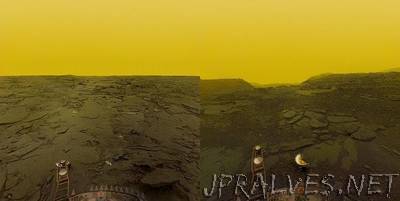
“Venus is one of the most inhospitable places in the solar system. Descending through the clouds of boiling sulphuric rain is actually the easy bit—the hard bit is not being cremated by the surface temperature of 470°C (878°F) or crushed by the atmospheric pressure, which is about 90 times that of Earth, the same as swimming 900 metres under water. The longest survival time for a human-made object on Venus was 127 minutes, back in 1981 when the Soviet spacecraft Venera 13 landed there. Not dying for two hours, and netting our first ever colour photos of the planet’s surface, was considered a huge success; the probe had only been designed to live for 32 minutes before it was cooked, crushed, and dissolved by its environs. Three more spacecraft followed, all Soviet—Venera 14, Vega 1, Vega 2—but we haven’t tried to land anything on Venus since 1985.”
